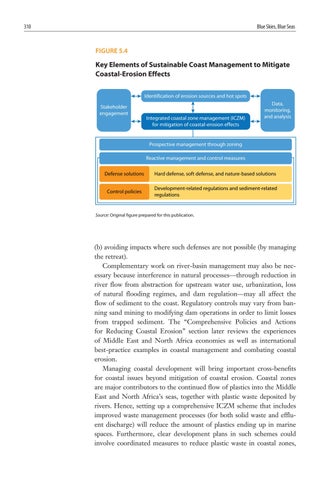310
Blue Skies, Blue Seas
FIGURE 5.4
Key Elements of Sustainable Coast Management to Mitigate Coastal-Erosion Effects Identification of erosion sources and hot spots Stakeholder engagement
Integrated coastal zone management (ICZM) for mitigation of coastal-erosion effects
Data, monitoring, and analysis
Prospective management through zoning Reactive management and control measures Defense solutions
Hard defense, soft defense, and nature-based solutions
Control policies
Development-related regulations and sediment-related regulations
Source: Original figure prepared for this publication.
(b) avoiding impacts where such defenses are not possible (by managing the retreat). Complementary work on river-basin management may also be necessary because interference in natural processes—through reduction in river flow from abstraction for upstream water use, urbanization, loss of natural flooding regimes, and dam regulation—may all affect the flow of sediment to the coast. Regulatory controls may vary from banning sand mining to modifying dam operations in order to limit losses from trapped sediment. The “Comprehensive Policies and Actions for Reducing Coastal Erosion” section later reviews the experiences of Middle East and North Africa economies as well as international best-practice examples in coastal management and combating coastal erosion. Managing coastal development will bring important cross-benefits for coastal issues beyond mitigation of coastal erosion. Coastal zones are major contributors to the continued flow of plastics into the Middle East and North Africa’s seas, together with plastic waste deposited by rivers. Hence, setting up a comprehensive ICZM scheme that includes improved waste management processes (for both solid waste and effluent discharge) will reduce the amount of plastics ending up in marine spaces. Furthermore, clear development plans in such schemes could involve coordinated measures to reduce plastic waste in coastal zones,






